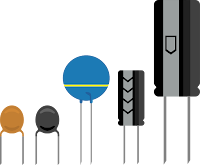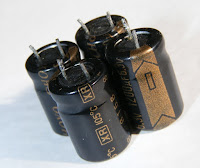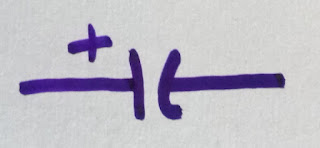CAPACITORS
A capacitor is a passive two-terminal electronic component
that stores electrical energy in an electric field. The impact of a capacitor
is known as capacitance.
Symbols and Units
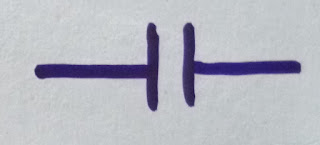 |
| Fixed Capecitor |
 |
| Variable Capecitor |
Unit: Farad
In its essential structure, a capacitor comprises of at least
two parallel conductive (metal) plates which are not associated or contacting
one another, however are electrically isolated either via air or by some type
of a decent protecting material, for example, waxed paper, mica, earthenware,
plastic or some type of a fluid gel as utilized in electrolytic capacitors. The
protecting layer between a capacitors plates is regularly called the
Dielectric.
Because of this protecting layer, DC flow can not move
through the capacitor as it squares it permitting rather a voltage to be
available over the plates as an electrical charge.
Type of Capecitors
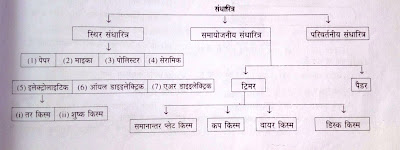 |
| Type of Capecitor |
Working
The conductive metal plates of a capacitor can be either
square, round or rectangular, or they can be of a barrel shaped or circular
shape with the general shape, size and development of a parallel plate
capacitor relying upon its application and voltage rating.
At the point when utilized in an immediate flow or DC
circuit, a capacitor energizes to its supply voltage yet obstructs the
progression of flow through it in light of the fact that the dielectric of a
capacitor is non-conductive and essentially a protector. Notwithstanding, when
a capacitor is associated with a substituting current or AC circuit, the
progression of the current seems to go straight through the capacitor with next
to zero opposition.
There are two sorts of electrical charge, positive charge as
Protons and negative charge as Electrons. At the point when a DC voltage is put
over a capacitor, the positive (+ve) charge rapidly gathers on one plate while
a relating and inverse negative (- ve) charge collects on the other plate. For
each molecule of +ve charge that touches base at one plate a charge of a
similar sign will withdraw from the - ve plate.
At that point the plates remain charge impartial and a
potential distinction because of this charge is set up between the two plates.
When the capacitor achieves its relentless state condition an electrical flow
is unfit to move through the capacitor itself and around the circuit because of
the protecting properties of the dielectric used to isolate the plates.
The progression of electrons onto the plates is known as the
capacitors Charging Current which keeps on streaming until the voltage
crosswise over the two plates (and henceforth the capacitor) is equivalent to
the connected voltage Vc. Now the capacitor is said to be "completely
energized" with electrons.
The parallel plate capacitor is the least complex type of
capacitor. It tends to be built utilizing two metal or metallised foil plates
at a separation parallel to one another, with its capacitance esteem in Farads,
being fixed by the surface region of the conductive plates and the separation
of partition between them. Modifying any two of these qualities adjusts the
estimation of its capacitance and this structures the premise of activity of
the variable capacitors.
Additionally, on the grounds that capacitors store the
vitality of the electrons as an electrical charge on the plates the bigger the
plates or potentially littler their partition the more noteworthy will be the
charge that the capacitor holds for some random voltage over its plates. At the
end of the day, bigger plates, littler separation, more capacitance.
By applying a voltage to a capacitor and estimating the
charge on the plates, the proportion of the charge Q to the voltage V will give
the capacitance estimation of the capacitor and is in this way given as: C =
Q/V this condition can likewise be re-masterminded to give the well-known
recipe for the amount of charge on the plates as: Q = C x V
In spite of the fact that we have said that the charge is put
away on the plates of a capacitor, it is increasingly precise to state that the
vitality inside the charge is put away in an "electrostatic field"
between the two plates. At the point when an electric flow streams into the
capacitor, it energizes, so the electrostatic field turns out to be a lot more
grounded as it stores more vitality between the plates.
Similarly, as the present streaming out of the capacitor,
releasing it, the potential distinction between the two plates diminishes and
the electrostatic field diminishes as the vitality moves out of the plates.
The property of a capacitor to store charge on its plates as
an electrostatic field is known as the Capacitance of the capacitor. That,
however capacitance is likewise the property of a capacitor which opposes the
difference in voltage crosswise over it.
Standard Units of
Capacitance
• Microfarad (μF)
1μF = 1/1,000,000 = 0.000001 = 10-6 F
• Nanofarad (nF)
1nF = 1/1,000,000,000 = 0.000000001 = 10-9 F
• Picofarad (pF)
1pF = 1/1,000,000,000,000 = 0.000000000001 = 10-12 F
Capacitance
The capacitance (C) of the capacitor is equivalent to the
electric charge (Q) isolated by the voltage (V).
C= Q/V
Capacitors in
arrangement
The all out capacitance of capacitors in arrangement,
C1,C2,C3,..
1. Capacitors in
parallel
The all out capacitance of capacitors in parallel,
C1,C2,C3,..
C Total = C1+C2+C3+...
2. Capacitor's
present
The capacitor's fleeting voltage vc(t) is equivalent to the
underlying voltage of the capacitor, furthermore 1/C times the fundamental of
the passing capacitor's present ic(t) after some time t.
Capacitor's
voltage
The capacitor's flitting voltage vc(t) is equivalent to the
underlying voltage of the capacitor, also 1/C times the indispensable of the
transient capacitor's present ic(t) after some time t.
Energy of
capacitor
The capacitor's store energy EC in joules (J) is equivalent
to the capacitance C in farad (F) times the square capacitor's voltage VC in
volts (V) partitioned by 2:
EC = C × VC 2/2
Read more>> WLAN
Bluetooth Technology
